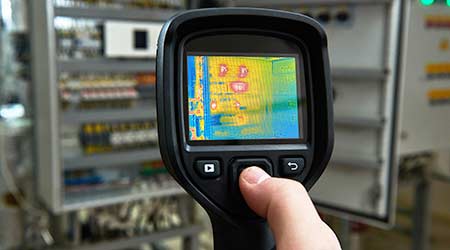 Infrared imaging systems are complex, so managers specifying new systems should not overlook the need for operator training.
Infrared imaging systems are complex, so managers specifying new systems should not overlook the need for operator training. Detecting Water in Roofs with Infrared Imaging
Technology and application advances put more power in the hands of managers and technicians
The inspection of building roofing systems has become perhaps the most common applications for thermal imaging. Water that has penetrated the roofing membrane and become trapped in the roof’s insulation changes the heat flow through the roof, something imaging systems detect easily. Identifying the extent of water damage is particularly important when evaluating whether to repair or replace a roof. A thermal inspection can identify the extent of the damage and help managers make a smart decision.
Roof thermal inspections must take into consideration a number of factors to produce accurate results. Technicians need to conduct scans at night well after the roof has had time to cool. The roof should be free of standing water and debris. They also need to note HVAC systems that might be discharging warm building air onto the roof, as well as the space located directly under the roof. For example, ventilated open spaces and hot mechanical rooms can skew the data from the scan.
Managers also can apply thermal imaging to examine other portions of the building envelope. Technicians can use it to detect faulty or missing insulation and areas where water has penetrated the envelope. In concrete construction, the technology can detect delamination and spalled areas, and it can identify sections of missing or failed grout in masonry construction.
Eyes in the sky
One of the most important developments in the field of thermal imaging is the use of the systems combined with drones. Equipped with thermal scanners, drones can give managers an images of surfaces, components and equipment that otherwise is time-consuming and difficult or impossible to get using handheld systems. Technicians can inspect utility substations and other electrical equipment easily, quickly, and safely with a drone equipped with a thermal imager.
Roof inspections have become one of the most common applications for thermal imaging drones. Flat and pitched roofs are easily imaged by a drone much more quickly and safely than by a handheld unit. Images produced by the drones showing the full extent of damage to the entire roof can make the repair-or-replace decision easier and more accurate.
Technicians can scan building envelopes in more detail with a drone than by using a handheld imager. They also can identify areas with missing, damaged, or insufficient insulation in detail, as well as areas where water has penetrated the envelope.
Managers should not overlook the need for training. Thermal imaging systems are complex. The images and data that they produce are subject to interpretation. Maximizing the investment in the systems requires that operators understand the capabilities and limitations of their systems if they are draw proper conclusions from the surveys.
James Piper, P.E., is a national facilities consultant based in Bowie, Md. He has more than 30 years of experience with facilities maintenance, engineering and management issues.
Related Topics:










